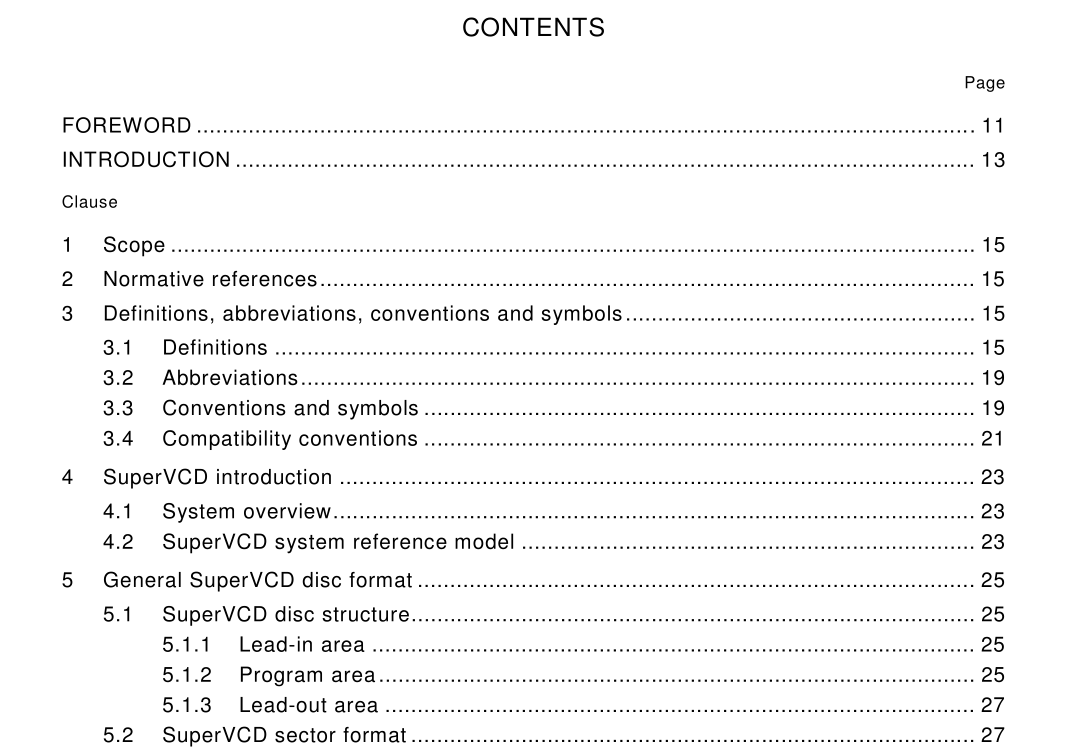IEC 62107 pdf download

IEC 62107 pdf download.Super video compact disc – Disc-interchange system-specification
1 Scope
This International Standard defines the basic specification of the Super Video Compact Disc, (SuperVCD), characterized by high resolution and high picture quality, which matches current TV receivers. This standard is intended to be used as a basis for the design, production and compliance testing of SuperVCD discs and playback devices to achieve compatibility with current and future products. The general SuperVCD disc structure is based on the CD-ROM system (see ISO/IEC 10149).
3 Definitions, abbreviations, conventions and symbols
3.1 Definitions 3.1.1 bit rate rate at which a compressed bit stream is delivered to the input of a decoder 3.1.2 mnemonics descriptions of different data types used in this standard Byte ordering – Quantities which require more than eight bits for their representation are held in more than one byte on the disc. For all such quantities, the ordering of bytes on the disc (as seen at the interface to the disc driver) is such that the Most Significant Byte (MSB) is first and the Least Significant Byte (LSB) is last. Multiple-byte quantities are represented graphically such that the left-most or upper-most byte is most significant and the right-most or lower-most byte is least significant.A disc with extensions should play on a playback device only supporting the mandatory functionality of the specification, and a playback device supporting some or all extensions should also play discs without these extensions. The specification also includes optional meta-data, intended to support improved performance of a playback device. It is recommended that optional items be recorded on the disc, but it is not required that they be included.
4 SuperVCD introduction
4.1 System overview SuperVCD is a reproduction system for presenting full motion pictures with associated audio by using the Compact Disc format. The system uses the ISO/IEC MPEG2 standard definitions to compress the video, still picture and audio information for full screen TV quality pictures together with associated high-quality audio. The SuperVCD disc can also carry high-quality still pictures with associated audio and a Play Sequence Descriptor file for interactive control of the playback of still and motion pictures. Variable bit rate (VBR) MPEG coding is used for more efficient use of the disc capacity. The playing time for a fully recorded disc can vary from 35 min to more than 70 min depending on the average bit rate used. The SuperVCD format is based on the CD-ROM Mode 2 disc format. SuperVCD discs can be played on SuperVCD playback devices, and other compliant hardware and software platforms.
5 General SuperVCD disc format
The general SuperVCD disc structure is based on the CD-ROM system (ISO/IEC 10149) with the specific additions and restrictions defined in this clause. The disc is intended to be played either sequentially starting from the first MPEG Track, or by playing Play Lists using the Play Sequence Descriptor (PSD) with on-screen “menu” control. A karaoke/music application has normally one track per song. This means that song number 1 is recorded in Track No. 2, and song number 2 in Track No. 3, and so on. A movie title can be divided into different coded parts, such as INTRO, COPYRIGHT, FILM, CREDITS. The film itself can also be subdivided into chapters.5.1.3 Lead-out area The lead-out area is encoded as a CD-ROM DATA track containing Empty Sectors of Mode 2 Form 2 with file number = $00, and Submode = $20. 5.2 SuperVCD sector format A track is divided into Mode 2 sectors of 2 352 sequential bytes each. Each sector can be uniquely addressed by a BCD-coded absolute time value in the header field of the sector. SuperVCD information is stored in SuperVCD sectors. There are two types of SuperVCD sectors, namely Form 1 and Form 2 sectors. A Form 1 sector has an extra Error Correction Code (ECC) field, as in CD-ROM Mode 1. A Form 2 sector is intended for real time MPEG data and has no ECC field, but 2 324 user data bytes instead, giving a 14 % higher bit rate or capacity.









